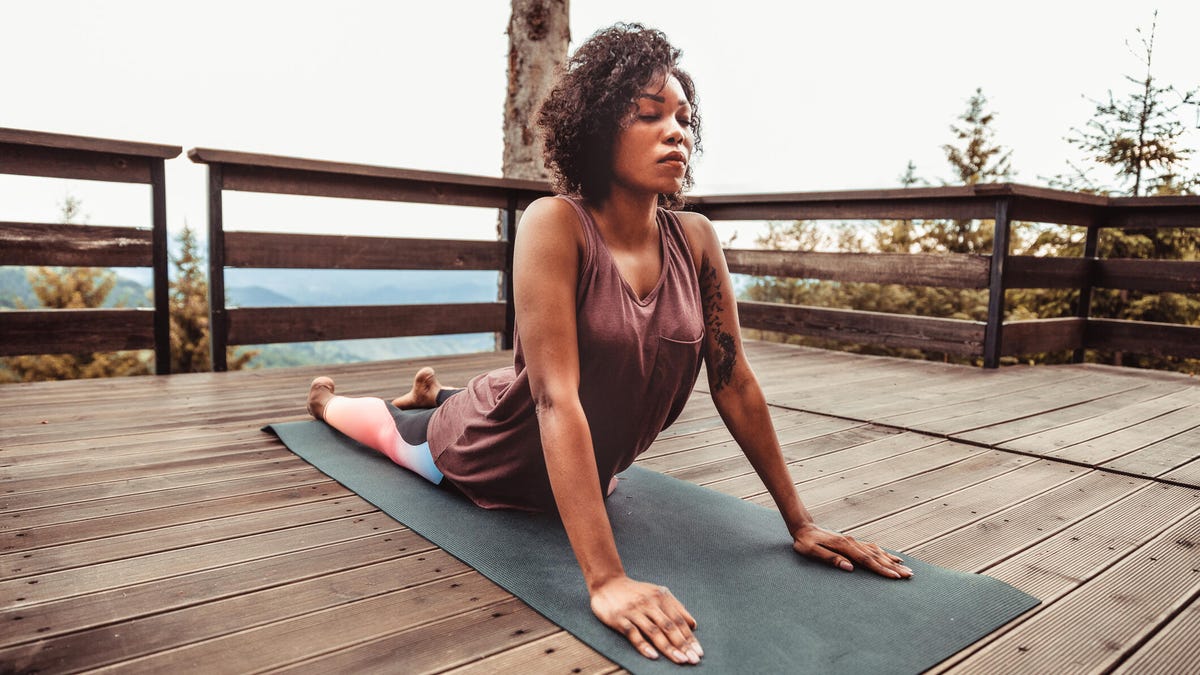 Why You Can Trust CNET
Why You Can Trust CNET Try These Exercises to Fix Your Posture
Prevent slouching and improve your form with these posture-targeting workouts.

Yoga is one workout that can help improve your posture.
You may not think about your posture when you're working out, but the truth is some types of exercise improve posture more than others. Even though you may be more concerned about how many miles you can get in or how you're improving your weightlifting game, posture is an important factor in both exercise and everyday life.
"Carving the time to improve your posture will ultimately set you up with better day-to-day form, improving balance and distribution of weight, especially during exercise, and minimizing the risk of injury and muscle strain," says Lee Jay, a certified personal trainer and Pilates instructor.
Some workouts can help set you up for success with better posture, especially ones like Pilates and yoga that focus on alignment, and working muscles in a balanced manner. If you're looking for workouts that can help improve your posture, keep reading below to find out which workout is right for you.
Pilates exercises for better posture
Pilates classes are low-impact, yet seriously challenging workouts. Pilates classes also have a huge focus on form and correct alignment, which pays off for your posture. "As a mat Pilates instructor, I'm constantly preaching the importance of good posture. Pilates is one of the most effective forms of movement to not only improve, but also bring mindfulness to how we sit, stand and even lie down," Jay says.
Pilates exercises Jay recommends for better posture include:
Spine twist
"[The spine twist] promotes elongation of the upper spine and engages the abdominal muscles in a steady seated position, whilst dropping the shoulders and engaging the belly. Through pelvis stability, the body is able to twist along the central vertical axis to improve flexibility along the spine, whilst training the body to maintain good form."
Reverse plank bridge
"Lengthens and straightens the lower back, and also corrects rounded shoulders. As the chest opens up, the shoulders round back and the spine aligns into place. This exercise is effective at targeting major muscle groups responsible for good posture, including the rhomboids, front deltoids and hip flexors."
Shoulder bridge
"On the upward phase, the weight is evenly distributed through the feet as you push up and raise the glutes, bringing the hips over the rib cage. The overhead arm reach encourages the spine to remain long and the shoulders to drop from the ears. On the downward phase, the spine drops one vertebra at a time, like a bicycle chain in motion, as the arms lower and the glutes rest on the mat with the back imprinted."
Barre exercises for better posture
Barre classes have foundations in dance and pilates, which means there's usually a heavy focus on core work. "Strong abdominals are essential to protecting the lower back, as well as assisting with better posture," says Andrea Rogers, founder and CEO of Xtend Barre.
Heel raises
Barre classes are total body workouts, but Jay says one unique move that most barre classes incorporate that can really benefit posture is heel raises. When you lift the heels in certain exercises, you are working muscles in your feet and legs, which can support good posture.
"Heel lifts can help in placing the feet in a position which encourages the rest of the body to fall into line. As the heels raise, muscles fire up as the pelvis tucks under, the quads engage to strengthen the knees, the arms raise overhead, dropping the shoulders away from the ears and bringing the spine into alignment," Jay says.
Yoga exercises for better posture
With a focus on flexibility, strength and balance yoga is a great complement to almost any exercise routine or lifestyle. In terms of posture benefits, yoga is a front-runner since the core and back muscles are engaged; many of the "slouch" muscles are countered by chest and upper-body opening poses.
Cobra pose
Jay likes cobra pose since it's, "An excellent movement to reverse the 'slouched effect,' increasing capacity in the lungs and relieving tension and stress in the body. After the cobra, you tend to naturally stand taller," Jay says.
"Starting in a lying-down position on the belly, slide the hands to your side as the elbows draw in by the rib cage. The whole body is engaged as the shoulders roll back and the upper section lifts off the ground, opening up the chest and stretching the spine, improving flexibility in this region."
Strength training exercises for better posture
The key to strength training for better posture is to make sure you're incorporating posture-targeted moves into your routines. Full-body strength training routines are great to ensure you hit all the muscle groups for better posture.
"Posture consists of a string of muscle groups which come into play throughout the body. From the feet, to the hamstrings, large back muscles, shoulder girdle and the head, the body is a chain in which one bad link can cause a defect elsewhere," Jay says.
Deadlift
"Doing a deadlift with proper form will help promote excellent everyday posture, as it targets the posterior chain. The weight doesn't necessarily need to be heavy in order to reap the benefits of this movement," Jay says.

